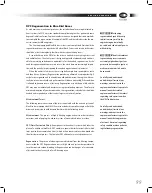
VISION
D R I V E R S H A N D B O O K
84
Engine Cooling System
In today’s modern engine designs, accurate maintenance of the cooling system is
critically important to engine life. Simply maintaining coolant level and performing
occasional coolant changes does not adequately ensure that the cooling system is
healthy. The chemical balance of engine coolant must always be correct. This re-
quires dilligent adherance to the engine manufacturer’s coolant specifications, main-
tenance schedules, and procedures. Accurate coolant system maintenance records
should be kept.
The engine coolant level in the reservoir should be checked daily as a part of
routine pre-trip inspection. But whenever the coolant level is low, it must be replen-
ished with only pre-mixed coolant of the same type and brand installed. Never top
off coolant with plain water.
Careful pre-trip inspection and a program of routine maintenance checks of the
condition of the cooling system by service technicians should ensure against enroute
emergencies such as worn hoses or loose clamps resulting in coolant loss. In the case
of such an emergency, however, if anything other than original premixed coolant is
added in order to allow the bus to proceed to a service facility, the coolant system
must be completely drained, flushed, and properly refilled with approved coolant
before being returned to routine service. Any enroute event requiring topping off
of the coolant should be reported to service personnel responsible for maintenance
of the bus.
[WARNING]
Exercise extreme care when removing the cap from the engine
coolant reservoir. Always allow time for the engine to cool before removing
the cap. The pressurized coolant may be very hot and can spray out, causing
serious burn injuries.
coolant Types
Engine coolant is generically divided between two types; “standard” and “long-life”
(or “extended-life”). Extended-life coolants generally allow longer intervals between
coolant changes (sometimes requiring additives to be added near the midpoint of
their service life, and/or for special testing to be performed at certain intervals). En-
gine manufacturers, however, differ somewhat in regards to specificaitions for cool-
ants which they recognize as “long-life” when used in their respective engines.
Blue Bird buses built as of March 26, 2009 come from the Blue Bird factory with
one of two types of coolant. The standard coolant is Fleetguard ES Compleat 50/50
premix, which is blue in color. This coolant is considered standard life when installed
in Cummins engines.
Cummins equipped buses purchased with an extended life coolant option have
been filled with Fleetguard ES Optimax 60/40 premix, which is red in color.
Содержание VISION 2011
Страница 1: ...10013333 2011 BBCV D R I V E R S H A N D B O O K 10013333 BBCV BLUE BIRD VISION 2011 ...
Страница 2: ......
Страница 3: ...10013333 Revision B ...
Страница 8: ...VISION D R I V E R S H A N D B O O K 6 ...
Страница 26: ...VISION D R I V E R S H A N D B O O K 24 ...
Страница 70: ...VISION D R I V E R S H A N D B O O K 68 ...
Страница 137: ...135 Notes n o t e s ...
Страница 138: ...VISION D R I V E R S H A N D B O O K 136 Notes ...
Страница 139: ......
Страница 140: ...10013333 2011 BBCV D R I V E R S H A N D B O O K 10013333 BBCV BLUE BIRD VISION 2011 ...






























